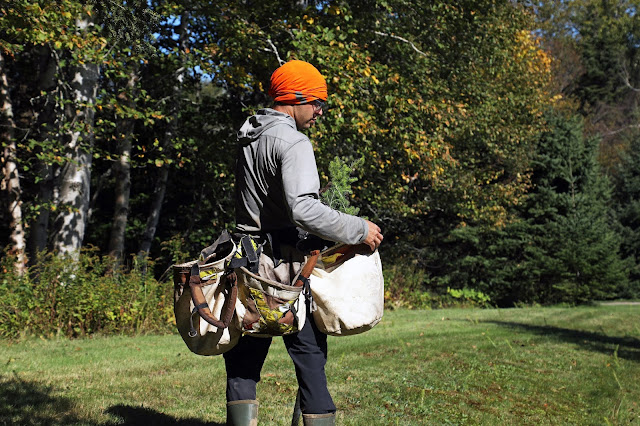This fall, Replant.ca Environmental started a long-term planting project at Hopewell Rocks Provincial Park. This park is located in southeastern New Brunswick. This work was made possible thanks to a sponsorship from the Trees For Life organization. Learn more about Trees For Life at www.treesforlife.ca
Hopewell Rocks Provincial Park is only a 35 minute drive from Moncton, down to the south through Riverview. The park is situated on the world-famous Bay of Fundy. The park itself doesn't have camping sites, although there are private campgrounds open to the public only a few minutes away, such as Ponderosa Pines. Incidentally, ponderosa pine is not a native species to New Brunswick. Now I'm curious to know whether there are any imported ponderosa pines growing at the campground. But let's get back to the topic of the day. Here's a photo of Mattea, planting a sugar maple seedling:
Here's a graphic (courtesy of Google Earth) showing the location of the park:
Hopewell Rocks is famous due to its iconic beach rocks, which tell a story interwoven by time, tides, and the intricacies of nature. Located on what is officially known as the Hopewell Rocks Ocean Tidal Exploration Site, these rocks (also known as the Flowerpot Rocks) are composed of sandstone and sedimentary conglomerate rock. The rock formations were originally part of the shoreline, but over time, water eroded cracks in the cliffs and eventually caused some parts to appear to have become "separated" from the main cliffs. As tides come in and out, the water gradually erodes the base of the rocks underneath the high tide line, causing the unique shape. In 2016, part of the Elephant Rock sheared off, as was noted in this CBC article:
https://www.cbc.ca/news/canada/new-brunswick/hopewell-rocks-new-brunswick-collapse-1.3491431
That article has some good photos, including a photo at the bottom that illustrates the enormous difference in water level between low tide and high tide. The Bay of Fundy has some of the world's largest tides.
If you'd like to learn more about the park, their website is a great resource:
www.parcsnbparks.info/en/parks/33/hopewell-rocks-provincial-park
The Replant.ca Environmental team planted 10,960 young seedlings within the park in 2021. A total of four species were planted: Red spruce, eastern white pine, northern (red) oak, and sugar maple. This was the first phase of a multi-year program, and both the species diversity and the number of hardwoods will be increased significantly in the future. We plan to eventually provide more than sixteen different species (six conifers and ten deciduous) to the park.
The team covered a number of different planting areas within the park. Here are a few photos of the team in action at Hopewell Rocks:
You can see more photos of our 2021 tree planting work in our public 2021 Planting Photos folder on Dropbox.
We'd like to thank Erika (the Park Manager) and her staff for their hospitality and support while we were on site. We definitely look forward to returning in 2022 to continue the work that Trees For Life is making possible.
Update: Here's the post describing the work that we did at Hopewell Rocks in 2022!
replant-environmental.blogspot.com/2023/02/tree-planting-project-at-hopewell-rocks.html
Jonathan "Scooter" Clark
Replant.ca Environmental is a Canadian company that plants trees for carbon capture and builds community forests. We also plant trees in national, provincial, and municipal public parks to mitigate damage from wildfires, storms, insects, and forest diseases. We operate thanks to numerous small contributions from the general public, in addition to larger project sponsorships from businesses and corporations around the world. If you'd like to learn how to show your support, visit our donations page. Even if you aren't able to make a contribution, we very much appreciate when people are able to share our posts or our website link on social media, to help spread the word about the work that we're doing!
To learn more about the various species that we plant, visit the conifers page or the deciduous (hardwoods) page on our website. Thanks so much for your interest!
Incidentally, our organization is often seeking additional land for our carbon capture projects. Please visit this link if you might know of a recently-harvested property that we could rebuild into a permanent legacy forest.








No comments:
Post a Comment